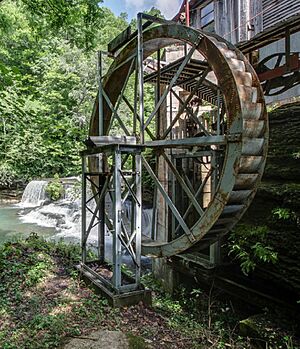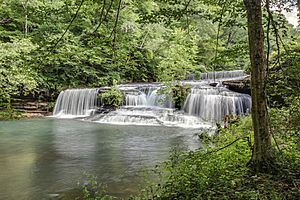G.T. Wilburn Grist Mill facts for kids
The G.T. Wilburn Grist Mill is an old mill located in the Fall River community, near Leoma, Tennessee. A grist mill is a place where grains like corn and wheat are ground into flour or meal. This mill played a very important role in the lives of people in its community for many years.
Contents
Where is the G.T. Wilburn Grist Mill Located?
The G.T. Wilburn Grist Mill is found in the small Fall River community. This community is part of the larger area around Leoma, Tennessee. Leoma is an unincorporated community, meaning it's a small settlement without its own local government.
The mill is in Lawrence County, Tennessee. This county had about 41,990 people in 2013. The biggest city in Lawrence County is Lawrenceburg, Tennessee.
The closest big city to the mill is Nashville, Tennessee. Nashville is about 76 miles north of the mill and is a much larger city. The mill is also only about 13 miles from the David Crockett State Park in Lawrenceburg, Tennessee.
The Mill's Long History
Early Days of the Fall River Community
The G.T. Wilburn Grist Mill has a long and interesting history. Back in 1823, the mill and a general store were the most important places in the Fall River community. As the mill became more successful, other buildings were added. These included two churches, a school, a blacksmith shop, and even a cemetery. The peaceful valley grew into a busy community.
For over 130 years, the mill, general store, and the family home served many needs. Besides grinding wheat and corn for food, the store was also used for many other things. It was a post office, a restaurant, and even a courtroom for judges. People would come to vote there, listen to political speeches, and borrow books from a small library. It was also a place for fun, hosting boxing matches, horseshoe tournaments, and checker games. It truly was the heart of the Clear Creek Valley.
The Civil War and Rebuilding
In 1862, during the American Civil War, soldiers from the Union Army came through middle Tennessee. They followed a "scorched earth" policy, which meant they burned down important buildings. Sadly, they burned the mill to the ground. This was a terrible loss for the Fall River community. Even though the mill owner and his family were safe, it was a devastating blow. However, as soon as the war ended, the people worked hard to rebuild their community. They showed a true pioneer spirit.
New Owners and Improvements
About 20 years later, in 1885, new family members arrived who would become the current owners of the Fall River properties. They brought new technology and equipment for grinding wheat and corn. They also built a dam across Clear Creek. This dam created a large, 30-acre pond. This pond allowed the mill to run all day and night, even when the creek was low during dry seasons. Fall River began to thrive again, and its success helped the Clear Creek Valley for the next 50 years.
G.T. Wilburn's Leadership
In 1914, G.T. Wilburn, who was the second generation of the new owners, took over managing the mill and the general store. Under his leadership, the mill became even more productive. He was very clever at adapting to new ideas and was known for grinding the best wheat and corn products. This made the mill famous in the region. People would travel from up to 50 miles away to visit the mill, especially as more people started owning Henry Ford cars and trucks. In 1924, G.T. and his wife Florence bought out the other family members. They dedicated their lives to the Fall River community.
A Walk Back in Time
Imagine taking a walk back 200 years to the early 1800s. You can stroll around the historic water-powered mill at Fall River. If you listen closely, you might almost hear the faint voices of mule drivers and the creaking of wagon wheels. They would arrive early in the morning with heavy loads of wheat and corn, ready for a long day at the mill. These early pioneers were happy to be there. They would meet their neighbors, share stories, catch up on local news, and shop for supplies at the general store while waiting for their grains to be ground. This food was essential for their survival through the coming winter.
Photo gallery
















